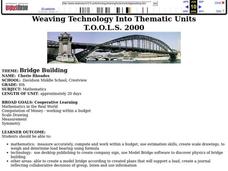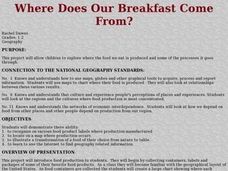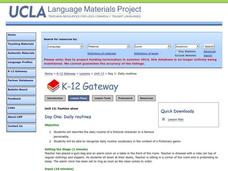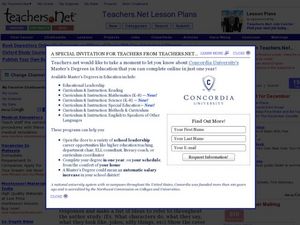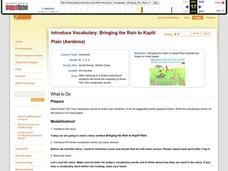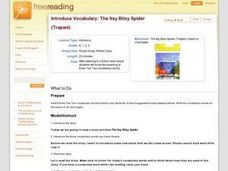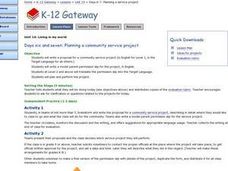Curated OER
Selecting a State Fish
Students work in groups to select a state fish for their state. They review reference materials to make a list of state characteristics and select a fish that best exemplifies the state.
Curated OER
Bridge Building
Eighth graders will create model drawings of bridges and integrate technology into the process of creating a visual representation. Technology is used in the industry of design and architecture. This lesson plan helps to build real life...
Curated OER
Night of the Twister
Young scholars use reading strategies for Night of the Twister. In this reading strategies instructional activity, students name five major catastrophes and books about each. Young scholars complete a vocabulary section, make inferences...
Curated OER
Introduce Vocabulary: The Circus is Coming
Students explore language arts by reading a story book in class. In this tier two vocabulary lesson, students read the book The Circus is Coming and identify the use of specific vocabulary words. Students define the selected vocab words...
Curated OER
Poetry Power
Second graders explore language arts by analyzing poems in their class. In this word play activity, 2nd graders define the terms rhyme, rhythm and alliteration and identify their uses. Students utilize class word lists to write their own...
Curated OER
Awesome Saturn
Pupils brainstorm words that describe Saturn. They view images sent to Earth from satellites. They write poems about the planet using different poetic forms.
Curated OER
Ancient History Cyber-Journalists
Students describe and assess circumstances surrounding a major historical event from the ancient world by using Internet (and other) resources to research its location, people, and repercussions, & write a newsletter that summarizes...
Curated OER
Expressive Mixed Media Collage
Students create a collage that expresses color, symbols, and collage techniques. They view and discuss paintings, create a collage book that communicates their interests, and write a question about each collage in the class.
Curated OER
Where Does Our Breakfast Come From?
Students bring in the cartons and containers of some of their favorite foods. They locate the origin of these foods on a map and visit a farm to view how food is grown and processed by a farmer. Students read books, complete worksheets...
Curated OER
How to Summarize
Students review techniques on how to read a passage smoothly making the words connect, and with expression. They then read the instruction to the chapter in their science book and answer questions that are written on the board. They...
Curated OER
Covering and Surrounding
Students develop techniques for estimating the area of a circle and use ideas about area and perimeter to solve practical problems. For this area and perimeter lesson, students apply the concepts of perimeter and area to the solution of...
Curated OER
Daily Routines
Students describe the daily routine of a person using a different language. In this foreign language vocabulary lesson, students discuss the different items people use to get ready every day and practice using those vocabulary...
Curated OER
Robert Munsch: Author Study
Young scholars study Robert Munsch's style of writing. In this literature lesson, students read many of Robert Munsch's books, write a list of the characteristics found in his books, and write or orally tell a...
Curated OER
Introduce Vocabulary: Bringing the Rain to Kapiti
Students develop new word knowledge by reading a children's book in class. In this vocabulary lesson, students read the book Bringing the Rain to Kapiti Plain, and identify the use of three specific vocabulary words. Students define the...
Curated OER
Introduce Vocabulary: Curious George Rides a Bike
Students explore language arts by reading a classic book in class. In this story vocabulary lesson, students read the book Curious George Rides a Bike and identify the use of specific vocabulary words. Students define the selected words...
Curated OER
Introduce Vocabulary: The Great Kapok Tree
Students explore language arts by reading a children's book in class. In this tier two vocabulary lesson, students read the book The Great Kapok Tree and identify the use of vocabulary terms. Students define the selected vocab words and...
Curated OER
Introduce Vocabulary: The Itsy Bitsy Spider
Students explore language arts by reading a children's book in class. In this story vocabulary lesson, students read the book The Itsy Bitsy Spider and identify the use of specific vocabulary words. Students define the selected vocab...
Curated OER
Mother's Day
Students construct Mother's Day cards. In this holiday lesson, students use art supplies to create Mother's Day cards. Students may include an acrostic poem about their mother or a coupon book for their mother.
Curated OER
MP3-Ring Circus
Young scholars explore the meaning of copyright and copyright issues surrounding the use of downloaded music.
Curated OER
Absolute and Relative Location
Second graders understand the difference between relative and absolute location using the grid map as an example of an absolute location. They observe a class map showing longitude and latitude lines and learn that they provide exact...
Curated OER
Speed Dating
Students describe their personalities and characteristics to a partner using short sentences or short oral paragraphs. In this short sentences lesson plan, students use a speed dating format.
Curated OER
Planning a Community Service Project
Students practice using a new language to plan a community event. In this civics lesson, students practice writing a proposal for a community project using their target language. Students brainstorm in small groups what their...
Curated OER
Rainforests: What Are They?
Second graders investigate rain forests by reading a habitat checklist. In this environment lesson, 2nd graders read the book The Great Kapok Tree, and discuss what characteristics make up a rain forest. Students explore a...
Curated OER
Write Your Own Folk or Fairy Tale
Students analyze folk and fairy tales. In this language arts lesson, students discuss the elements of a tale determining what the differences are between folk and fairy tales. Students then write their own tales using the graphic...

